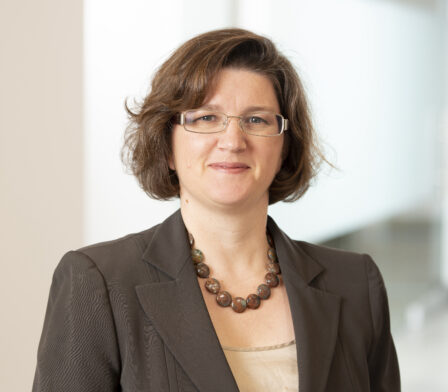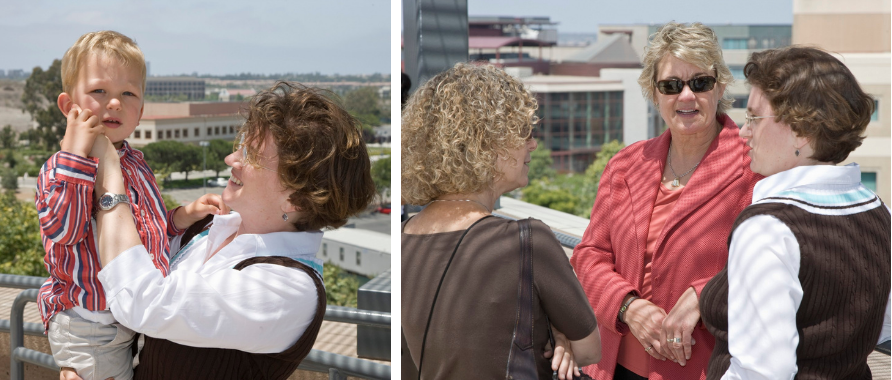Darya Chudova Blends Fields to Advance Disease Diagnosis
Alumni Spotlight: Darya Chudova (Ph.D. ’07) helps advance liquid biopsy for cancer screening and treatment by merging two distinct fields of study.

Darya Chudova estimates that she failed five times before succeeding to unite the fields of computer science and medicine. “One of the defining aspects of my career is how many times I have tried to blend the two in different ways,” says Chudova, who earned her Ph.D. in computer science from UC Irvine’s Donald Bren School of Information and Computer Sciences (ICS) in 2007. She has since found success in biotech as chief technology officer for Guardant Health, a company developing new genomic technologies for clinical diagnostics from blood samples. In her eight years at Guardant Health, Chudova has led technology development to widen clinical applications and improve the performance of liquid biopsy tests. Most recently, Guardant has developed technology for blood-based colorectal cancer screening, which is currently under review with the U.S. Food and Drug Administration. Here, Chudova — a 2024 ICS Hall of Fame inductee — describes her quest to bridge the gap between different fields of expertise, becoming a bit of an interpreter and a detective in her early days in biotech. She also talks about mentors at UCI who afforded her opportunities to “spread her wings” as she balanced both professional development and family life.
What sparked your interest in biotech?
My family background! They were divided between mathematicians and doctors. I pursued math during high school, but wasn’t good enough to do pure math in college, so applied research and computer science were the next best things. I then tried to navigate from computer science to as close to medicine as one could get, and I’m very happy with where I ended up!
One of the defining aspects of my career is how many times I have tried to blend the two in different ways. I failed maybe five times before I succeeded, so I always tell people they should keep exploring until they find the right combination.
What led you to UCI to pursue your Ph.D. in computer science?
Before I came to this country from Moscow, Russia, I dabbled in a lot of work that could be loosely described as data analysis, which was a much more nascent field than the field of data science is today. After I immigrated, I started working at a company in Orange County, where my role was to bridge the gap between computer programmers and statisticians. I was fascinated by the latter and was excited learning on the job from all the folks who were developing models of the data, but I quickly realized it would be difficult to work on the more interesting problems unless I went back to school for my Ph.D. I was lucky enough that UCI was nearby, and my personal connections led me to Padhraic Smyth. Then a casual conversation about his program quickly turned into, “What do you think about me joining your Ph.D. program?”
Padhraic offered to have me join his group knowing that I had a baby on the way. He was so open to me building both my professional and family life, which was an amazing adventure. He was also in the area that I was most interested in — developing complex probabilistic models and applying them to real-world scientific data — so I was very lucky to have him as my advisor. It created a phenomenal opportunity for me.

What then put you on your career path in the biomedical space?
UCI was really my first foray into the biomedical and bioinformatics domains, and it was fantastic that Padhraic was open to it. I started working on problems that had nothing to do with medicine or biomedical data, but as I said, I was on a quest to apply the knowledge I’d gained in computer science to an area where I’d be excited about the outcome of my work.
With Padhraic’s support, I entered a new graduate program that offered students the opportunity to have a joint advisory committee between a computer science professor and a life sciences professor. Within this program, in addition to Padhraic Smyth, I started being advised by Bogi Andersen in the School of Medicine, which allowed us to solve problems together that had applications in the biomedical domain. I also connected with a group of other graduate students who wanted to be at the crossroads of multiple disciplines. It was a perfect configuration for me as a student, and I’m very grateful to UCI for creating an environment where I could spread my wings into other areas.

How did you then transition into industry?
I’m grateful for Bogi Anderson, who helped me find my first position in the biotech industry at a startup called Veracyte. It was created to analyze genomic signs of cancer in the biopsy specimens taken from thyroid nodules, with the goal of preventing surgeries to remove the thyroid when the traditional cytological evaluation of the biopsy could not definitively rule out cancer. Veracyte continues to offer this clinical test today, helping identify patients with benign versus malignant thyroid nodules and preventing unnecessary thyroid surgeries.
From there, I went to work in a different field, focusing on prenatal testing. Instead of doing the invasive amniocentesis procedure, as was commonly done for high-risk pregnancies at the time, the idea was to do a noninvasive blood draw, made possible by the rapid development and accessibility of the next-generation sequencing technology. These ideas were being simultaneously developed in multiple academic centers, and a few companies built the practical technologies and tools needed to enable this analysis at scale and bring these tests into the hands of physicians for clinical use.
As we were working on improving these tests, we discovered that some of these asymptomatic pregnant women were carrying the signatures of yet undiagnosed cancer in their bloodstream. We started investigating this with some academic collaborators, and it was clear that the blood draw could reveal something incredibly important for patients. Seeing this data and the potential impact, I decided to join a company (Guardant Health) dedicated to the analysis of tumor fragments found in circulation. The hope was that the large amounts of data collected in relevant clinical samples would eventually enable better outcomes in both early cancer detection and patient treatment.
Can you tell us more about liquid biopsy and its potential?
Guardant Health was a pioneer in the space of liquid biopsy, which enables the analysis of a tumor by profiling of DNA fragments originating from the tumor through non-invasive blood samples instead of the primary tumor biopsy. In late-stage cancer patients, where primary tissue biopsy is not always feasible, liquid biopsy helps identify optimal treatment based on the tumor’s mutation profile within one week of the blood draw.
When I joined, the company was already offering such tests to patients. There was still skepticism in the field at that time about the ability to profile tumors from blood, but within a few years, discussions at every relevant scientific conference were offering new clinical questions that could be addressed by liquid biopsies.
In cases of advanced cancer, treatment decisions are now made routinely using liquid biopsy. Furthermore, molecular traces of residual disease are being evaluated in early-stage cancer patients after initial treatment interventions to inform decisions about subsequent therapies. These are just examples of many clinical applications for liquid biopsy that the field continues to be excited about.
Ultimately, the hardest question is, could the analysis of blood samples be informative in asymptomatic individuals who don’t have any signs of cancer, helping us identify early traces of the disease when treatment is much more likely to succeed? We’re actively exploring what that could look like as a screening tool, along with many other companies in this space.
Can you also talk about your various roles and what you like most about your job?
When I think about my early days working in biotech, I would say I was often either an interpreter or a detective.
I had to acquire translation skills because the field is very cross-functional and interdisciplinary in nature. You cannot do anything in the space of complex clinical diagnostics development today unless you have a team whose knowledge spans different areas of expertise. We have chemistry and molecular biology experts working on optimizing how we analyze our samples; cancer genomics experts who help us define which biomarkers could help answer different clinical questions; engineering teams working on robotic platforms automating the processing of patient samples in the lab; data scientists analyzing various signals and structuring large amounts of data; and software developers putting all these components into clinical decision systems. We are always trying to develop new capabilities, which is why you need to bring the folks from these diverse backgrounds together and have someone translate the language of these different experts to create integrated solutions.
The detective part comes from tackling scientific challenges along the way. As you work on new developments, you have to be able to parse the complexity of interactions, reviewing your hypotheses and sifting through evidence to investigate how to move forward. I enjoy both aspects tremendously, which is a benefit of being in the biomedical space.
Do you have any words of advice for prospective students interested in biotech?
You must have curiosity and mental agility. A big part of what it means to be in the biomedical industry is being able to learn new domains. You need to be comfortable in a space where you don’t necessarily have the full expertise. This field is great for people who are good at collaborating and finding ways to combine expertise to come up with a sum that’s greater than the individual components.
It’s also important to learn how the data comes about in terms of the biology that drives the primary signals and the technology that was used to generate the observable data. Being able to understand all these underpinnings is key.
Also, try not to become too frustrated with how relevant — or irrelevant — some topics might seem in your graduate school classes. From an educational perspective, you learn certain subjects or techniques that, as you get into industry, become somewhat obsolete. But the ways in which your education teaches you how to think about the problem is absolutely crucial and something that continues to make your past schooling experience relevant and advantageous in industry.
Can you also talk about any challenges you faced as a woman in STEM, or share a role model?
I had the luxury of working with Padhraic, who nurtured my learning in an environment supportive of my work and family. I also learned that if you want to have both family and professional roles in your life, trying to be perfect in both worlds is not the way to go. You will have to give up something in one corner of your life to create space for the other one. Find peace straddling between those two imperfect worlds.
Early in my professional studies and career, I didn’t pay a lot of attention to gender roles, but I later found myself in boardrooms with fewer and fewer female leaders at the table. I had a role model in Bonnie Anderson, who was the CEO during my first biotech startup experience. She understood so much about the business and taught many of us how to make “clinical decision impact” the key driver of company direction. She also showed us how to be a leader who cares not only about the business but also the people surrounding us in the work world. I didn’t necessarily think of her as a “female” role model, but I learned so much from her experience and passion.
I think just putting yourself in an environment where you can learn and thrive is a huge part of being successful.
— Shani Murray